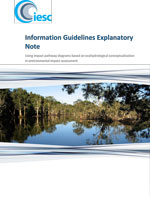
Independent Expert Scientific Committee on Unconventional Gas Development and Large Coal Mining Development
Information Guidelines Explanatory Note - Using impact pathway diagrams based on ecohydrological conceptualisation in environmental impact assessment

About the document
For some topics, Explanatory Notes have been written to supplement the Independent Expert Scientific Committee on Unconventional Gas Development and Large Coal Mining Development (IESC) Information Guidelines, providing tailored guidance and up-to-date robust scientific methodologies and tools for specific components of environmental impact assessments.
The Information Guidelines Explanatory Note - Using impact pathway diagrams based on ecohydrological conceptualisation in environmental impact assessment promotes the use of impact pathway diagrams based on ecohydrological conceptualisation in environmental impact assessment to map sources, pathways and receptors of impacts arising from, for example, Large Coal Mines and Coal Seam Gas development.
On 15 December 2023, the Nature Repair (Consequential Amendments) Act 2023 amended the EPBC Act to expand the IESC’s remit to all unconventional gas developments. This publication was developed prior to these amendments of the EPBC Act commencing.
The summary guide provides a short, simplified summary of the Explanatory Note for proponents and consultants. Updates to IESC Information Guidelines and Explanatory Notes will be undertaken as new methodologies and tools become available.
